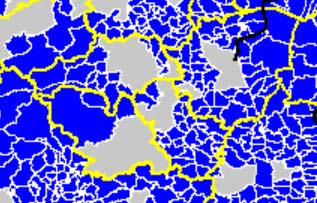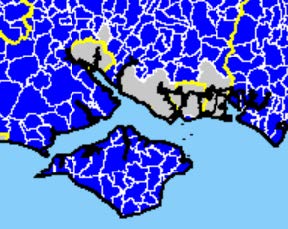In this page:
- In addition to proposals for new bodies operating above the level of local councils, some people argue for decentralisation of some powers to neighbourhoods below the level of existing councils.
- Local councils often cover large populations. This means that those influenced can be distant from their decisions.
- On some issues, the people who live in a local community may be best placed to make local decisions. On other issues, decision-making on a larger scale might be more effective.
- There are various ways in which power might be devolved down to more local neighbourhoods.
The main ideas for reforming local government that you will hear about in the news at the moment focus on creating new bodies that are larger than existing councils. But some people think we should go the opposite way, decentralising power from local councils to even more local neighbourhoods, such as towns, villages, or suburbs.
Not everything can be decentralised to more local levels: decentralisation of powers can be combined with keeping some powers at local council level and developing larger city (or even bigger) regions to deal with other issues.
What’s the basic idea?
Local councils often cover large areas or large populations, which means that decision-making can often seem very distant from local communities.
In the Assembly North region, for example, the Sheffield city council covers a population of over half a million people and includes places like Stocksbridge and Dore as well as Sheffield itself. Barnsley council includes Penistone in the west and Bolton upon Dearne in the east. Doncaster council stretches from Mexborough to Thorne. Precise population figures are given in the box on the right.
Barnsley: 238,000
Doncaster 304,000
Rotherham 260,000
Sheffield 564,000
In the Assembly South area, the Isle of Wight council covers the whole island, which stretches around 20 miles from west to east and 10 miles from north to south. Eastleigh includes Hedge End and Hamble-le-Rice. Fareham includes Locks Heath and Stubbington. Havant includes the whole of Hayling Island. Full population figures are in the box on the left.
Local Council Populations: Assembly South
Southampton: 254,000
Eastleigh: 129,000
Fareham: 114,000
Gosport: 84,000
Portsmouth: 209,000
Havant: 122,000
Isle of Wight: 138,000
People who favour decentralisation to local neighbourhoods argue that some matters could better be dealt with at a more local level. They argue this would make it easier for local people to get involved in decision-making and for decisions to reflect particular local needs and priorities.
There are various different ideas about how power could be decentralised further. We set these out in the following sections.
Creating smaller local authorities
The most radical option would be to create new, smaller local authorities to replace the existing councils. If new ‘combined authorities’ are created to take over large-scale issues, the case for smaller local authorities looking after more local issues may be stronger.
Many of the current local authorities have been created by combining council areas that were previously separate.
- In the Assembly North area, for example, places like Penistone, Wath-upon-Dearne, and Mexborough all once had their own councils within the West Riding of Yorkshire.
- In the Assembly South area, the Isle of Wight is particularly notable. Until 1995, it had two districts: Medina and South Wight. These were created in 1974 from six even smaller districts
Giving more powers to parish and town councils
The second option is to give greater powers to parish and town councils. In other briefing papers, we have outlined the main elements of the current local government system: unitary councils in some areas, and district and county councils in other areas. But many parts of the country also have a lower tier of government that currently is very weak.
Parish councils represent villages or rural areas and town councils cover towns. They can also be called community, neighbourhood, or village councils. Note that ‘parish’ councils are not connected to the church.
Some parts of the country do not have parish or town councils: they are called ‘unparished’ areas. In general, larger urban areas are unparished, while rural areas and smaller towns have parishes.
The maps on the right show parished areas within the Assembly North and South regions in blue and unparished areas in grey.
In South Yorkshire, the main population centres of Barnsley, Doncaster, Rotherham, and Sheffield are all unparished, as are Mexborough and Dearne. Other, more rural areas all have parish or town councils, the largest of which are Ecclesfield, Maltby, Thorne, and Hatfield.
Most of urban south Hampshire is unparished. The exception is Eastleigh, most of which does have parishes. The whole of the Isle of Wight is also covered by parish or town councils.
Parish and town councils currently have limited powers and limited budgets. According to the National Association of Local Councils, which represents parish and town councils, these councils:
‘provide and maintain a variety of important and visible local services including allotments, bridleways, burial grounds, bus shelters, car parks, commons and open spaces, community transport schemes, community safety and crime reduction measures, events and festivals, footpaths, leisure and sports facilities, litter bins, public toilets, planning, street cleaning and lighting, tourism activities, traffic calming measures, village greens and youth projects’
Decentralising powers to local area committees
A third option is to stick with existing councils (unitary councils, district councils, and county councils), but decentralise the way in which they work. Some councils make some decisions through neighbourhood committees whose members are the councillors from each particular area.
Eastleigh District Council, for example, organises some of its activities through six ‘local area committees’. According to the council, these deal with ‘local matters including planning applications and planning enforcement, traffic management, environmental improvements, leisure facilities, local refuse collections and recycling’. Money is devolved to each area committee to perform these functions.
Most of the areas covered by Assembly North and Assembly South do not have neighbourhood committees. Eastleigh is the only part of the Assembly South area that has such committees. In the Assembly North area, only Barnsley currently has local area committees. These have budgets, but they have fewer powers then the area committees in Eastleigh.
Some other areas – such as Sheffield have had area committees in the past, but have abandoned them in the face of the need to make budget cuts. This reflects the fact that decentralising power in this way does generate some costs.
One reform could be to introduce local area committees where they do not currently exist. Another would be to increase the powers of local area committees.
Holding local consultations and deliberative events
Many local areas – not just in the UK, but also around the world – have experimented with giving local voters a direct say in decision-making in their areas.
One option is to hold meetings that anyone can attend in order to decide certain matters. Some local councils – such as Sheffield and Rotherham – have tried this approach. It has the advantage of allowing anyone how wants to take part to do so. The disadvantage is that the people who are able and willing to attend a meeting may not be representative of the whole local population.
Another option is a gathering such as Assembly North or Assembly South, where people are invited to participate and the organisers work to ensure that the people who take part are as representative of the community as possible.
You will find more details of these kinds of arrangements in our page on Citizen Participation in Decision Making.
Advantages and disadvantages of decentralisation
On the other hand, some local decisions – such as decisions on building new roads or houses – typically affect a much wider area, so need to be considered more strategically. Some services are best organised on a larger scale so that they can be provided efficiently and effectively. And decentralisation may mean that the process of decision-making itself costs a little more to run.
Where to from here?
- If more combined authorities are created, then one option will be for smaller authorities to replace local councils.
- A second option is to give more powers to parish and town councils.
- Another option is for local councils to devolve more decisions to neighbourhood committees.
- Still another option is for councils to hold more citizens’ assemblies like this one in local communities.


